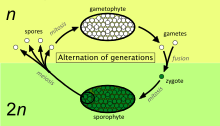– Life cycle
– Sporophyte develops from fertilization of haploid egg cell by haploid sperm
– All land plants and most multicellular algae have alternating sporophyte and gametophyte phases
– Sporophyte produces spores through meiosis
– Spores develop into haploid gametophyte
– Gametophyte produces male/female gametes by mitosis
– Fusion of gametes forms diploid zygote
– Zygote develops into new sporophyte
– Cycle known as alternation of generations
– Examples
– Mosses have dominant gametophyte generation
– Flowering plants’ sporophyte comprises whole body except pollen and embryo sac
– Bryophytes have dependent sporophyte phase
– Algae have dominant gametophyte generations
– Clubmosses, horsetails, ferns, gymnosperms, and angiosperms have independent sporophytes
– Evolutionary history
– Plants evolved heterospory during Devonian period
– Some plants have endospory, while others have exosporous development
– Seed ferns developed female gametophytes within sporangia
– Heterospory and endospory crucial in seed evolution
– rRNA genes behavior differs in bryophytes and seed plants
– See also
– Alternation of generations
– References
– Reski R: Development, genetics and molecular biology of mosses
– Bateman RM, Dimichele WA: Heterospory key innovation in plant evolution
– Matyášek R et al.: Unique epigenetic features of rRNA genes in early diverging plants
– Kenrick P, Crane PR: Origin and early evolution of land plants
– Taylor TN, Kerp H, Hass H: Life history biology of early land plants
A sporophyte (/ˈspɔːr.əˌfaɪt/) is the diploid multicellular stage in the life cycle of a plant or alga which produces asexual spores. This stage alternates with a multicellular haploid gametophyte phase.

